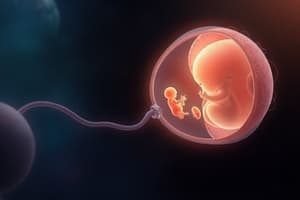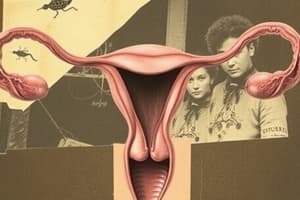Podcast
Questions and Answers
What is the primary role of the prostate gland in the male reproductive system?
What is the primary role of the prostate gland in the male reproductive system?
To produce fluid called semen that provides nutrients for sperm cells.
Describe the function of the sperm duct in the male reproductive system.
Describe the function of the sperm duct in the male reproductive system.
The sperm duct carries sperm and mixes it with fluids produced by glands before ejaculation.
What dual purpose does the urethra serve in males?
What dual purpose does the urethra serve in males?
The urethra carries urine from the bladder and semen during ejaculation.
What are the two main functions of the testes in the male reproductive system?
What are the two main functions of the testes in the male reproductive system?
Why is the scrotum important for sperm production?
Why is the scrotum important for sperm production?
What is the main function of the penis in the male reproductive system?
What is the main function of the penis in the male reproductive system?
What role does the sperm duct play before ejaculation occurs?
What role does the sperm duct play before ejaculation occurs?
How does the presence of testosterone influence the male reproductive system?
How does the presence of testosterone influence the male reproductive system?
What is the role of the placenta in terms of nutrient and waste exchange between the mother and fetus?
What is the role of the placenta in terms of nutrient and waste exchange between the mother and fetus?
Explain how the structure of the placenta supports its function in diffusion.
Explain how the structure of the placenta supports its function in diffusion.
Why are certain toxins and viruses able to cross the placenta, while others are not?
Why are certain toxins and viruses able to cross the placenta, while others are not?
What health complications can arise in a fetus due to the transmission of the rubella virus across the placenta?
What health complications can arise in a fetus due to the transmission of the rubella virus across the placenta?
How can smoking during pregnancy affect fetal health in relation to the placenta?
How can smoking during pregnancy affect fetal health in relation to the placenta?
What are some physical changes that occur in boys during puberty?
What are some physical changes that occur in boys during puberty?
At what age does the average menstrual cycle start for girls?
At what age does the average menstrual cycle start for girls?
What triggers ovulation in the menstrual cycle?
What triggers ovulation in the menstrual cycle?
What happens to the uterine lining if an egg is not fertilized?
What happens to the uterine lining if an egg is not fertilized?
How long does the average menstrual cycle last?
How long does the average menstrual cycle last?
What role do hormones from the ovary and pituitary gland play in the menstrual cycle?
What role do hormones from the ovary and pituitary gland play in the menstrual cycle?
What emotional changes might occur during puberty?
What emotional changes might occur during puberty?
How long does menstruation typically last?
How long does menstruation typically last?
What adaptive feature allows sperm to swim to the egg?
What adaptive feature allows sperm to swim to the egg?
What role do enzymes in the acrosome of sperm play during fertilization?
What role do enzymes in the acrosome of sperm play during fertilization?
Why are mitochondria important for sperm function?
Why are mitochondria important for sperm function?
What is the function of the cytoplasm in the egg cell?
What is the function of the cytoplasm in the egg cell?
How does the jelly-like coating of the egg cell protect it after fertilization?
How does the jelly-like coating of the egg cell protect it after fertilization?
Compare the size of sperm and egg gametes.
Compare the size of sperm and egg gametes.
What is the main structural difference between sperm and egg gametes?
What is the main structural difference between sperm and egg gametes?
How frequently are sperm produced compared to eggs in females?
How frequently are sperm produced compared to eggs in females?
What hormone is primarily responsible for egg maturation in the ovary?
What hormone is primarily responsible for egg maturation in the ovary?
What occurs when oestrogen levels reach their peak in the menstrual cycle?
What occurs when oestrogen levels reach their peak in the menstrual cycle?
How does progesterone affect the uterine lining?
How does progesterone affect the uterine lining?
What happens to the uterine lining when progesterone levels fall?
What happens to the uterine lining when progesterone levels fall?
What triggers the release of oestrogen during the menstrual cycle?
What triggers the release of oestrogen during the menstrual cycle?
Explain the role of LH in the menstrual cycle.
Explain the role of LH in the menstrual cycle.
During what days does oestrogen peak in the menstrual cycle?
During what days does oestrogen peak in the menstrual cycle?
What are the consequences of rising levels of FSH?
What are the consequences of rising levels of FSH?
What is the role of FSH in the menstrual cycle?
What is the role of FSH in the menstrual cycle?
How does oestrogen affect the uterine lining?
How does oestrogen affect the uterine lining?
What happens to progesterone levels if fertilization does not occur?
What happens to progesterone levels if fertilization does not occur?
What triggers the release of LH during the menstrual cycle?
What triggers the release of LH during the menstrual cycle?
What does the corpus luteum produce after ovulation?
What does the corpus luteum produce after ovulation?
What is the consequence of a drop in progesterone during the menstrual cycle?
What is the consequence of a drop in progesterone during the menstrual cycle?
What role does progesterone play during pregnancy?
What role does progesterone play during pregnancy?
How do hormonal interactions regulate the menstrual cycle?
How do hormonal interactions regulate the menstrual cycle?
Flashcards
What is the role of the prostate gland?
What is the role of the prostate gland?
The prostate gland produces a fluid called semen which nourishes the sperm cells.
What is the function of the sperm duct?
What is the function of the sperm duct?
The sperm duct is a tube where sperm cells travel through to mix with fluids from glands before being released during ejaculation.
What does the urethra carry?
What does the urethra carry?
The urethra carries urine from the bladder and semen during ejaculation. A muscular ring stops these fluids from mixing.
What are the two main functions of the testes?
What are the two main functions of the testes?
Signup and view all the flashcards
Why are the testes located outside the body in the scrotum?
Why are the testes located outside the body in the scrotum?
Signup and view all the flashcards
What is the function of the penis?
What is the function of the penis?
Signup and view all the flashcards
Why is it important that the temperature in the scrotum is slightly less than body temperature?
Why is it important that the temperature in the scrotum is slightly less than body temperature?
Signup and view all the flashcards
What is the role of testosterone in the body?
What is the role of testosterone in the body?
Signup and view all the flashcards
Sperm Flagellum
Sperm Flagellum
Signup and view all the flashcards
Sperm Acrosome
Sperm Acrosome
Signup and view all the flashcards
Sperm Mitochondria
Sperm Mitochondria
Signup and view all the flashcards
Egg Jelly Coat
Egg Jelly Coat
Signup and view all the flashcards
Sperm Size
Sperm Size
Signup and view all the flashcards
Egg Size
Egg Size
Signup and view all the flashcards
Sperm Motility
Sperm Motility
Signup and view all the flashcards
Egg Motility
Egg Motility
Signup and view all the flashcards
What is the placenta?
What is the placenta?
Signup and view all the flashcards
How does the placenta work?
How does the placenta work?
Signup and view all the flashcards
What are some substances that cross the placenta?
What are some substances that cross the placenta?
Signup and view all the flashcards
Why is it important to avoid toxins during pregnancy?
Why is it important to avoid toxins during pregnancy?
Signup and view all the flashcards
What are some viruses that can cross the placenta?
What are some viruses that can cross the placenta?
Signup and view all the flashcards
What causes ovulation?
What causes ovulation?
Signup and view all the flashcards
What stimulates the ovaries to release oestrogen?
What stimulates the ovaries to release oestrogen?
Signup and view all the flashcards
How does oestrogen affect the uterine lining?
How does oestrogen affect the uterine lining?
Signup and view all the flashcards
How does progesterone affect the uterine lining?
How does progesterone affect the uterine lining?
Signup and view all the flashcards
What happens during the menstrual cycle?
What happens during the menstrual cycle?
Signup and view all the flashcards
What is the role of the pituitary gland in the menstrual cycle?
What is the role of the pituitary gland in the menstrual cycle?
Signup and view all the flashcards
What is the purpose of menstruation?
What is the purpose of menstruation?
Signup and view all the flashcards
What is the relationship between oestrogen and LH?
What is the relationship between oestrogen and LH?
Signup and view all the flashcards
What is the role of oestrogen?
What is the role of oestrogen?
Signup and view all the flashcards
What is the function of progesterone?
What is the function of progesterone?
Signup and view all the flashcards
What is the relationship between oestrogen and progesterone?
What is the relationship between oestrogen and progesterone?
Signup and view all the flashcards
How is the menstrual cycle regulated?
How is the menstrual cycle regulated?
Signup and view all the flashcards
What happens during menstruation?
What happens during menstruation?
Signup and view all the flashcards
What is ovulation?
What is ovulation?
Signup and view all the flashcards
What is the typical length of the menstrual cycle?
What is the typical length of the menstrual cycle?
Signup and view all the flashcards
When does the menstrual cycle start?
When does the menstrual cycle start?
Signup and view all the flashcards
What causes the thickening of the uterus lining?
What causes the thickening of the uterus lining?
Signup and view all the flashcards
What happens when progesterone levels drop?
What happens when progesterone levels drop?
Signup and view all the flashcards
What is the role of FSH in the menstrual cycle?
What is the role of FSH in the menstrual cycle?
Signup and view all the flashcards
What effect does oestrogen have on the uterus lining?
What effect does oestrogen have on the uterus lining?
Signup and view all the flashcards
How does oestrogen influence FSH production?
How does oestrogen influence FSH production?
Signup and view all the flashcards
What triggers ovulation?
What triggers ovulation?
Signup and view all the flashcards
What happens to the follicle after ovulation?
What happens to the follicle after ovulation?
Signup and view all the flashcards
How does the corpus luteum contribute to pregnancy?
How does the corpus luteum contribute to pregnancy?
Signup and view all the flashcards
Study Notes
Sexual Reproduction in Humans
- Human reproduction involves sexual reproduction, characterized by the fusion of male and female gametes.
- Key structures and functions of the male reproductive system are detailed, alongside the functions of each part.
- Detailed breakdown of the female reproductive system and function of each part
- Gametes (sperm and egg) and their adaptations for fertilization and development are presented.
- The fertilization process, occurring in the oviducts, and the subsequent development of a zygote are explained.
- The development of the zygote into an embryo and then a fetus within the uterus is outlined.
- The role of the placenta in providing nourishment and removing waste for the developing fetus is elaborated.
- The process of virus transmission across the placenta, concerning various factors like concentration gradients and barrier function, is covered.
- Key hormones, such as oestrogen and testosterone, and their effects on secondary sexual characteristics are described.
- The menstrual cycle, including hormonal control, changes in the uterine lining, and the role of FSH and LH, are detailed.
- Diagrams of the systems and processes are included.
- Important stages of the menstrual cycle, including menstruation, ovulation, and uterine lining changes, are described.
- The interaction between all four hormones is discussed.
Studying That Suits You
Use AI to generate personalized quizzes and flashcards to suit your learning preferences.




